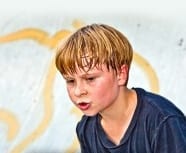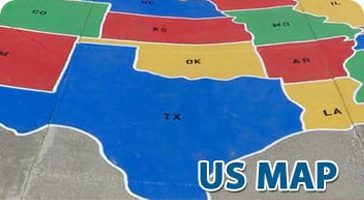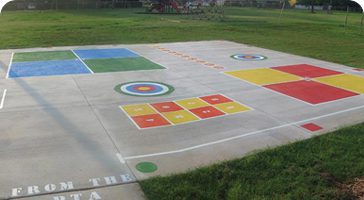Keeping Kids Cool At School
When is it too hot for recess?
By Dr. Melinda Bossenmeyer, The Recess Doctor

When is it too hot for recess?
As most of the nation head back to school facing triple-digit heat principals will begin to ask themselves, "When is it too hot for recess.?" In some parts of the nation schools face the challenges associated with outdoor recess and overheated classrooms. Principals and physical educators will face daily decisions regarding children's heat-health and is it too hot for recess?
In this article, we will review some information regarding different playground challenges and solutions to those problems.
Of particular concern to schools is that "kids absorb more heat than adults while sweating less. The result is kids have a greater propensity for heat cramps, exhaustion or heat stroke", according to Dr. Melinda Bossenmeyer, also known as the Recess Doctor.
The single most important factor to acknowledge is children seldom complain when overheated and most children rarely self-regulate.
Too Hot to Play?
So how hot is too hot for recess? The determination depends on a number
of factors including:
How high is the humidity,
How hot is it on the blacktop,
What kind of access do children have to water to hydrate,
Is there a shaded area with benches to cool off, and
Length of playtime and sun exposure.
The single most important factor to acknowledge is children seldom complain when overheated and most children rarely self-regulate.
Asphalt
A researcher from Columbia University in NY City found that when the air temperature outside was 91 degrees the surface heat of the asphalt was 134 degrees. The researcher, Stuart Gaffin, and his team are measuring ground and air temperatures and the amount of sunlight different surfaces reflect. Some of his other findings may surprise you.
In a recent interview with WNYC he pointed out that while some things are obvious: schools could use a lot more shade, black surfaces get a whole lot hotter than those painted white, blue, or red, or a nice green-grass lawn would be wonderful if it weren't pretty much impossible to maintain in a schoolyard, certain things are less obvious. For instance: Well-intentioned 'astroturf' appears to get even hotter than asphalt.

Playground Equipment
Playground equipment can heat up quickly and retain the heat easily, causing serious burns to skin upon contact. While it may not be too hot for recess, it may be too hot to play on playground structures. According to the U.S. Consumer Product Safety Commission (CPSC), young children are particularly at risk of second and third-degree burns because they don't react by pulling away from hot surfaces as quickly as older children do.
CPSC Safety Alert – Prevent Burns on Hot Metal Playground Equipment
A safety alert was issued by the CPSC regarding hot metal playground equipment in June 2009. The advisory points out that solid steel decks, slides, or steps in direct sunlight may reach temperatures high enough to cause serious contact burn injuries in a matter of seconds. The CPSC advises parents and school personnel to be diligent in checking the playground equipment which can reach 166 degrees in hot weather due to heat and sun exposure.
Here are the results of their testing. "When we checked a playground slide, the thermometer read 134-degrees. The children's swing was a white-hot 146-degrees. Some of the playgrounds coated metal steps read 133-degrees. The baby swing came in at a scorching 150-degrees."
The play structure readings were based on both plastic and metal play equipment. The News 4 crew then tested the mat playground surfacing. It measured a whopping 180-degrees! [ii]
Symptoms of Heat Injuries
Upon a return to the classroom, the symptoms of heat injuries often surface. Symptoms include:
1. Heat Cramps- the Early warning sign of heat exhaustion or stroke.
2. Heat Exhaustion- Extreme sweating, dry mouth, fatigue, headache, nausea, and/or
dizziness.
3. Heat Stroke- Considered a medical emergency. Body Temp above 104 degrees,
confusion, deep breathing, stop sweating, and loss of consciousness.
Prevention Strategies include:
Hydrate before and after physical activity.
Avoid sweet or caffeinated drinks that dehydrate.
Rest often at least every 20 minutes on hot days.
Allow hats for outside use.
Consider allowing water bottles in classrooms and playgrounds on hot days.
Shorten Recess and outdoor exposure.
Keeping Kids Cool at School is a Shared Responsibility
Parents and schools working together can mitigate this problem and keep kids safe. Parents can send their children to school ready to deal with the heat by:
Sending students in light-weight, loose-fitting, cotton clothing.
Make sure kids have a cap with a brim that protects the face.
Send the child with a small water bottle on a hot day.
Talk to their child about the dangers of getting overheated.
Schools can:
Allow water bottles at school so that teachers make sure their students have access to plenty of liquids.
Limit recess time outdoors.
Encourage sipping water frequently after time spent following physical activity.
Teach students warning signs of heat exhaustion.
When possible conduct activities in the shade.
Minimize time spent on playground structures or hot asphalt playgrounds.
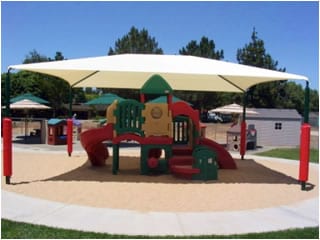
Strategies for Mitigating Hot Playground Exposure
Canopies or Shade Structures can make a big difference when it's too hot for recess.
Harbour View Elementary School in Summerfield, Florida began tackling the heat problem a few years back. They have installed a canopy that is hurricane-proof and blocks UV rays over the kindergarten playground structure. Kindergarten teacher, Melinda Boatright commented that it's working, "We don't see those red, flushed cheeks like we used to."
"The canopies provide a safer and more comfortable place to play," said Zanetti School Board Chairperson, adding that burns from the metal or mats have now been eliminated, as well as the potential for sunburns. "They're fabulous." The estimated cost of the canopies installed at all district elementary schools is approximately $15,000 each. An added bonus is that the P.E. program is using the space to teach physical education on hot days.
American Academy of Dermatology – Shade Structure Grant Program
If you have a grant writer, be sure to apply for the annual Shade Structure Grant offered through the American Academy of Dermatology. The American Academy of Dermatology's Shade Structure Program awards grants in the amount of $8,000 each for the purchase of permanent shade structures designed to provide shade and ultraviolet (UV) ray protection for outdoor areas. The AAD also provides a permanent sign to be displayed near the shade structure that promotes the importance of sun safety. The AAD receives support for this program from Johnson & Johnson Consumer Products Company.
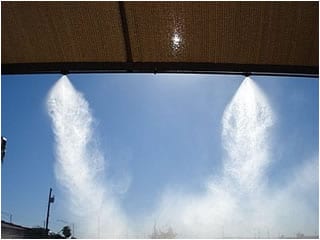
Playground Heat Solutions
Water Misters
With year-round schools in session, kids are spending recess in the sometimes scorching heat. Some schools are looking into ways to limit sun and heat exposure. That has some school officials across the nation looking for ways to block out the bright sun.
misters can drop the temperature by 10 degrees
Using misters can contribute to a 10 degree drop in the temperatures.
Dr. Melinda Bossenmeyer, Retired Principal from E. Hale Curran Elementary School in Murrieta, CA, and Peaceful Playgrounds Founder suggest that the solution is water misters. High pressure pumps stainless steel mist lines and brass misting nozzles produce microscopic droplets of water that cool the surrounding air down by 30 degrees.Curran Elementary installed the misters in covered structures after Murrieta transitioned its schools to year-round in the early '90s. It is not uncommon for temperatures to reach 105 degrees regularly during the months of July through September in the Murrieta area which is only about 50 miles from Palm Springs."The misters provide a much-needed relief from the sweltering summer sun and they were economical as well. Misters use little water and are inexpensive to install", according to Bossenmeyer. "It is well documented that students have a great deal of difficulty regulating physical activity in the heat. Many students play hard and get sick. We found that the students would self-regulate and go under the shade structures and cool off once the misters were installed."
E. Hale Current Elementary School Murrieta, CA
Hot weather, exercise, and dehydration a deadly combination
Scientists don't yet know why some people become seriously ill while exercising in hot weather, and others don't. "There's still a lot we don't understand" about heat illness, says Douglas Casa, an associate professor in the Department of Kinesiology at the University of Connecticut, who's extensively studied athletic performance in the heat.
Heat illness itself is an omnibus term, covering "a spectrum of seven or eight different conditions," that range from mild heat exhaustion to life-threatening heatstroke, Casa says. August is prime season for the illnesses, since, even as temperatures soar, many athletes must or choose to continue exercising outside.
Scientists have a pretty clear picture of what happens inside athletes as they exert themselves. They bake. Muscles in motion generate enormous amounts of energy, only about 25 percent of which is used in muscle contractions. The other 75 percent or so becomes body heat.

Exercising at play can raise core body temperature by almost 2 degrees every five minutes, "if no heat is removed from the body." Humidity also plays a villainous role, slowing or preventing the evaporation of sweat, one of the human body's main mechanisms for removing heat. For children, the sweating process becomes particularly problematic, as mentioned earlier, due to the fact that "kids absorb more heat than adults while sweating less".
The biggest issue in heat illness, then, is not the outside temperature, but the internal one. If a person's core body temperature rises to about 105 degrees Fahrenheit, a critical threshold, the consequences can be dire. The body overheats and puts a strain on the heart, pumping less blood to vital organs and bringing less of the rising core body heat to the skin's surface.
According to a recent article in the New York Times, "Why someone has more difficulty dissipating body heat on one hot afternoon rather than on another is still mysterious. But researchers do have a growing knowledge of some of the factors that predispose people to heat illness. Being out of shape or overweight, having a fever, a sunburn, or wearing too much, heavy clothing contribute. "
Additionally, an unusually hot spell in which the body has not had time to acclimate to the heat should be of concern to teachers and school administrators. Research indicates that "it's much harder for the body to cope with heat if it's not used to it." [iii]
Heat Exhaustion and Heat Stroke Treatment
When to Send Student to the School Nurse:
A school nurse may be appropriate for mild forms of heat exhaustion. Heatstroke is a medical emergency, and an ambulance should be called immediately. For mild cases of heat exhaustion:
Rest in a cool, shaded area.
Give cool fluids such as water or sports drinks (that will replace the salt that
has been lost). Salty snacks are appropriate as tolerated.
Loosen or remove clothing.
Apply cool water to the skin
When to Seek Emergency Medical Care
As with all other medical problems, a doctor should be called if you are not sure what is wrong, if you do not know what to do for the problem, or if the person is not responding to what you are doing for them.
Call a doctor for heat exhaustion if the person is unable to keep fluids down or if their mental status begins to deteriorate. Symptoms of shortness of breath, chest pain, or abdominal pain may indicate that the heat exhaustion is accompanied by more serious medical problems.
Suspected heat stroke is a true, life-threatening medical emergency. Call for an ambulance and request information as to what to do until the ambulance arrives.
A person with a suspected heatstroke should always go to the hospital (or call for an ambulance) at once. For heat exhaustion, a person should go to the hospital if any of the following are present:
1. Loss of consciousness, confusion, or delirium
2. Chest or abdominal pain
3. Inability to drink fluids
4. Continuous vomiting
5. Temperature more than 104°F
6. The temperature that is rising despite attempts to cool the person
7. Any person with other serious ongoing medical problems(from eMedicineHealth.com)
So when is it too hot for recess?
As explained in this article, that depends on the availability of shade, accessible water, cooling areas with water misters, humidity, types of surfacing, the age of children and length of playtime, and to name a few. It is recommended that you acquire local Heat Advisories that are produced by school districts and regional offices of education. Finally, limit children to short sessions of physical activity and ensure that they hydrate frequently on hot days and seek medical attention when in doubt.
Remember. Water bottles, sunscreen, hats, and verbal reminders are all a part of keeping kids safe in the summer sun.
District Guidelines and Heat Advisories
Most districts and state departments of education have established guidelines called heat advisories which spell out local procedures and identify points of contact for heat related information. We have attached some samples for your review.
Heat Advisory: Maine Health Alert Network
CDC Frequently Asked Questions About Extreme Heat
Kyrene School District Heat Index Guidelines and Procedures
LAUSD: Guidelines for Preventing Heat Stress
2023 LISD Hot & Cold Weather Guidelines

